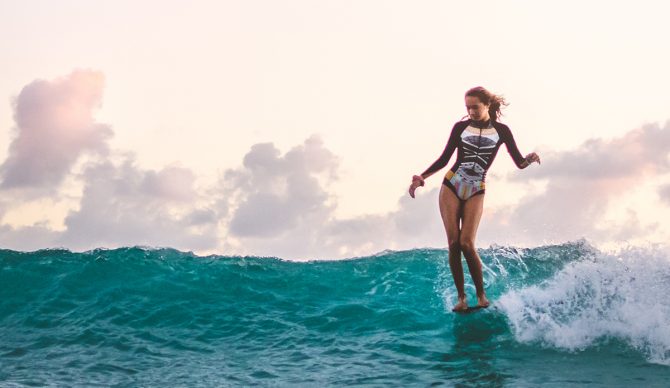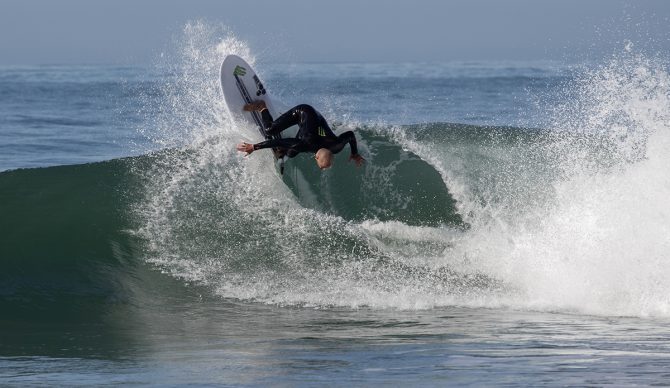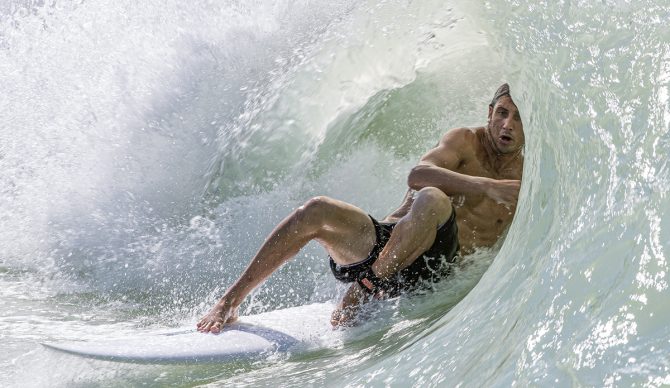
Small waves can still look beautiful. Photo: Will Walling
Take even a precursory cruise through contemporary surf media and it’s pretty easy to see that one of the biggest trends in surfing right now seems to be ragging on small waves. This isn’t to say that histrionic coverage of events like the epic Eddie, crazy Cortes and next-next level Nazarè isn’t justifiable — giant waves and the brave surfers who ride them have been capturing our collective imagination since the Honolulu Bulletin photographer “Scoop” Tsuzuki’s shot of Woody Brown, George Downing and Buzzy Trent riding Makaha Point Surf went “viral” in 1953. But along with that enduring fascination an exclusionary tone has crept into the conversation, an attitude shift that along with much of the media’s current visual presentation completely invalidates the typical surfing experience of virtually all its viewers/readers.
Big, gnarly slabs and dangerous, shallow reef barrels being described as “perfect;” surf forecasting sites that can time a swell’s arrival to the precise minute, yet regularly call the double-overhead waves depicted as being six-foot; a world champion labeled, with only thinly-veiled derision, as, “the best small-wave surfer in the world;” a young female tube-riding pioneer being forced by convention to talk about cutting her teeth in “three-foot Pipeline,” as if such a thing exists. And most egregious, the increasingly popular use of the term “proper” in describing waves that are bigger and more difficult to ride than the majority of surfers will ever encounter in their daily surf existence. Proper, meaning that any wave falling short of this arbitrary, idealized standard is somehow improper, with any enthusiasm, not to mention affinity for this sub-standard medium, embarrassingly misplaced. So pervasive is the idea that the only good wave is big, hollow and preferably scary that to challenge this perception is sure to draw fire, not only from certain online influencers and editors, but even plenty of surfers who, if you believe the aforementioned wags, have probably never ridden a “proper” wave in their lives. Yet in service to the rest of the surfing population, the question must be asked: What’s wrong with small waves?

Bobby Martinez, proving that high performance and wave height are not mutually exclusive. Photo: Jimmy Metyko
The answer: absolutely nothing. In fact, when viewed objectively it’s plain to see that while big waves are surfing’s greatest extravagance, small waves are its essence. First of all, with very few exceptions small waves are where you live; you don’t chase small waves, they come to you. You can count on them to be there. Though unremarkable, perhaps, they’re reliable, a key element to developing rapport with the surf. No torrid, “same time next year” affair, small waves offer the chance for a steady relationship, with a satisfying daily devotion taking the place of consuming waves of mad passion. They’re also free from the fleeting adrenaline/dopamine rush often associated with the addiction characteristic of “tolerance,” described as “the need to gradually increase the amount of a substance or behavior to achieve the same desired effects as previously experienced.” You can happily ride small waves for the rest of your life.
Small waves have shaped the boards you ride. In 1981 Simon Anderson designed the thruster in order to compete with Mark Richards’ small wave twin-fin performance. Before this the fish was designed for small waves, as was the egg, the sting, the modern longboard and more currently the Mini-Simmons, boards like the “Neck Beard,” and mid-lengths. Only a tiny percentage of surfers have tiny tow-boards and giant paddle-in guns in their quivers — the rest of the world rides small waves on small wave surfboards.
How those surfers ride can also be attributed to the small wave’s intrinsic validity. Only in small waves does one find the freedom to develop technique in a progressive arc rather than a series of consequential failures; performing without fists and sphincters clenched, a surfer can tap into the rhythm that even the most inconsequential waves contain, leading with their hips and not their guts, eventually attaining what our surf culture universally recognizes and reveres as “style”…or at least some degree of functional aptitude.

Getting small doesn’t mean going small. Clay Marzo, Waco. Photo: Jimmy Metyko
Most importantly, however, is the fact that riding small waves is fun. Yes, there are surfers out there who’ll claim that riding big waves is fun; that being rag-dolled and held underwater to the point of blackout, seconds from death, surviving only with inflatable vests, rescue teams and capable CPR, or having your skull wound stapled shut after being slammed head-first into the shallow coral reef, is all part of the fun, but there’s a whiff of yet another characteristic of addiction known as rationalization in these assertions. On the other hand, the riding of a small wave needs no explanation, no declarative statement of intent or display of fortitude. It is above and below of all things simply fun. You ride a small wave merely for the pleasure of doing so. As described by HMS Endeavor’s ships surgeon William Anderson in 1777, who, upon seeing a Tahitian out having fun surfing tiny waves in his outrigger canoe, noted what appeared to be the supreme pleasure of “being driven on so fast and so smoothly by the sea.”
And I haven’t even started to talk about wave pools.
No, small waves were good enough for that unnamed, yet obviously stoked Tahitian, and they’re obviously still good enough for the vast majority of surfers today. And when I say small wave, I’m talking sixty inches and under — if you think differently, well that’s just your ego talking, and a topic for a completely different discussion. Until then, your comments, as always, are welcomed.

